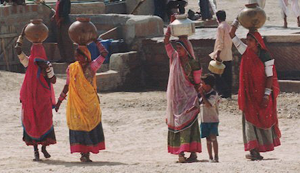Study suggests changes to Indian Monsoon may increase societal impacts by late 21st century
June 30, 2011
 Credit: USAID |
NOAA Earth System Research Laboratories researchers Marty Hoerling and Jon Eischeid are co-authors on a new study suggesting that changes in India's seasonal monsoon climate by the end of the 21st century could increase threats to humans and crops. The article, entitled The once and future pulse of Indian monsoonal climate, was published in the June 2011 issue of Climate Dynamics and is an analysis of global climate model projections in the late 21st century. Incorporating greenhouse gas influences, the model shows the potential for higher temperatures in the region than have ever been recorded in 130 years worth of instrumental data. These predictions estimate that although the total amount of rainfall during the monsoon season may be comparable to the present day, the duration of wet and dry spells could change appreciably, and the intensity of rain days may increase.
The health and economy of India is dependent on rains brought by the summer monsoon. Historically, even slight variations in regional weather has had catastrophic consequences on the wellbeing of Indian society. In 2010, NOAA signed with India's Ministry of Earth Sciences to provide an ocean-atmosphere general circulation model to help predict the Indian summer monsoon rainfall.
This study shows considerable evidence that temperatures in India will increase significantly in the 21st century causing more frequent and intense climate extremes, the result of which is likely to increase human mortality and decrease crop yields. Further improving climate models to project a variety of climate change impacts at regional scales will be essential to more accurately predict the monsoon hydrological cycle and help to further guide policy-makers facing vital decisions.
| Contact: Marty Hoerling | Related Information:
|